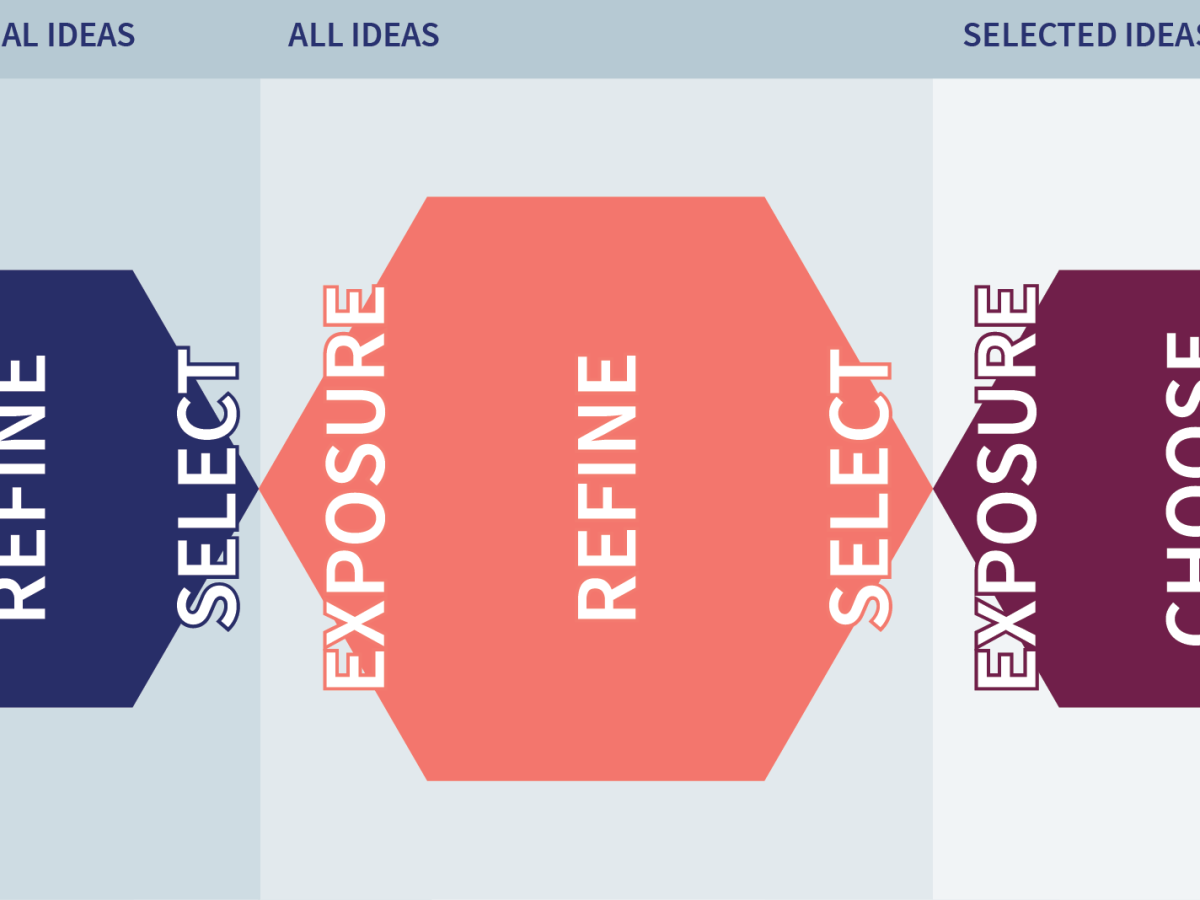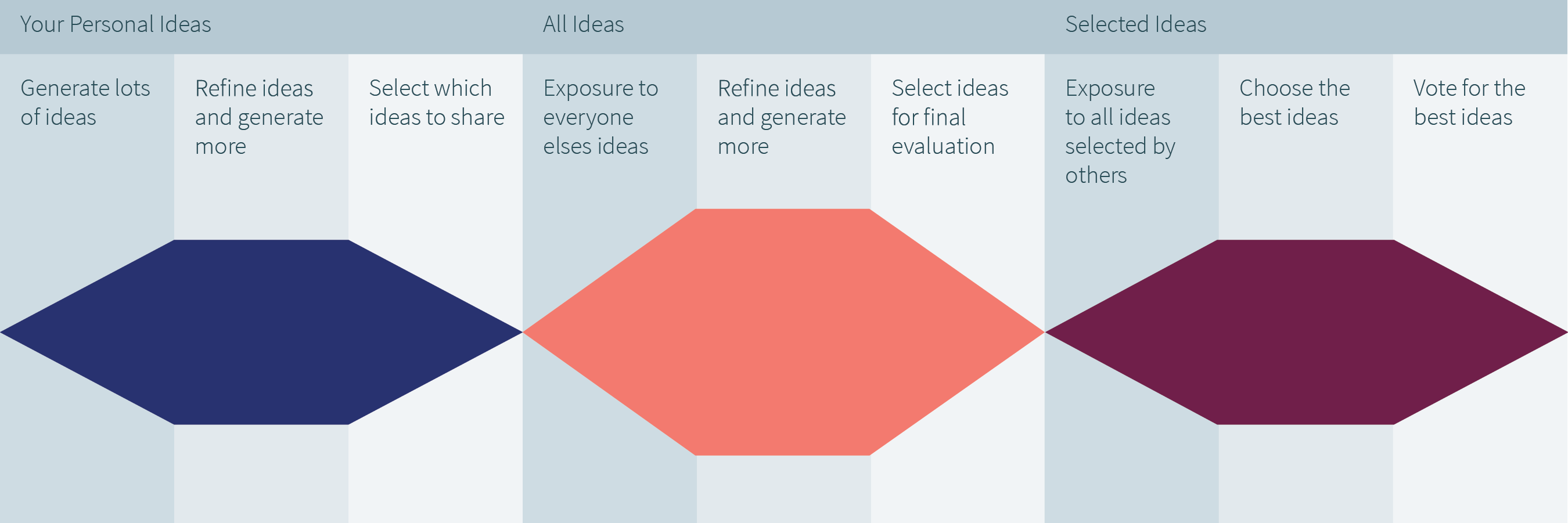
The Neonce evolved brainstorming method
Francesco Marcatto14 Mar 16
The Neonce brainstorming method is an evolved comprehensive process for conducting effective group problem solving and ideation sessions. The Neonce brainstorming method can be described as a three stages process, each containing both a divergent and a convergent phase, that carry the users from problem definition to the selection of the best ideas.
Method overview
Phase 1: Individual ideas generation
- individual idea generation (divergent process)
- selection of the most promising 3 ideas (convergent process) to be shared
Phase 2: Incubate and generate more
- share ideas and individual idea generation (incubation + divergent process)
- selection of the most promising 3 ideas from the total pool of shared ideas (convergent process) to be evaluated in the next phase
Phase 3: Final evaluation
- final share of ideas (divergent process)
- select the best idea(s) (convergent process)
Here is a graphical representation of the Neonce Method:

Phase 1: Individual ideas generation
In the first phase, the problem is stated and users must generate individually (without sharing). When they are satisfied, or when the time is over, users must select a maximum of 3 ideas to be shared with other group members.
Phase 2: Incubate and generate more
In the second phase, all the ideas selected by each user at the end of phase 1 are pooled and showed to all users. Users can spend some time going through all ideas and then they can generate more ideas individually. At the end of this phase, all users are required to select their favourite 5 ideas from the total pool of ideas (shared ideas + new generated ideas).
Phase 3: Final evaluation
In this final phase, the ideas selected by each group member are pooled, and users should select the best idea (or a number of ideas) using the most suitable selection method (for example, the 10-dots method, the 5-4-3-2-1 method, or the Scroop technique).
Theoretical background
The Neonce technique has been developed with the aim of creating a framework which could be used to improve electronic brainstorming. It is well known traditional face-to-face brainstorming leads to low performances, while adopting nominal groups or brainwriting techniques leads to improved quantity and quality of generated ideas. Electronic brainstorming can provide ulterior benefits, by putting together the effectiveness of brainwriting with the many advantages of computer mediated interaction (e.g., the physical presence is not required, it is easy to write, store, and share ideas, etc.).
Our experiences with popular electronic brainstorming applications, however, have been far from being impressive. Working synchronously on a shared screen resulted in what we called 'drag&drop wars', situations in which users are continuously being distracted by other users moving the ideas on the screen, and, more tragically, in information overload. After some minutes of creating ideas, the shared screen was filled with too many ideas that it was very difficult to organise and evaluate all that load of information. Quantity breeds quality, we have heard this a lot of times, but an excessive quantity leads to information overload and to decision paralysis (Schwartz, 2004). Too bad!
With the Neonce technique, we wanted to address these issues, maintaining at the same time the cognitive stimulation arising from information sharing. So, in the first phase of the Neonce process, we make users generate ideas individually (as in the nominal technique method), to improve the quantity of idea generation and avoid the pitfalls of production blocking, but then only a subset composed by the best ideas is shared to the other members. This way we reduce the amount of information and we make users reflect on their ideas (we must admit: most of our ideas are less than brilliant!). In the second phase users can see all the ideas that have been shared, and are asked to reflect on the shared ideas and continue to generate new ones. The idea behind this procedure is that exposure to others' ideas followed by an incubation period is cognitively stimulating (Paulus & Yang, 2000), so we mix individual generation with group stimulation. Again, users are asked to reflect on the ideas and to move to the final selection phase only the most promising ideas, in order to reduce the final selection stage to a reasonable amount of ideas. Lastly, the third phase is more than just a final selection, since in this last process users may see for the first time the ideas that other group members have generated and evaluated as great during the second phase.
As you can see, in the whole Neonce process, users are free to generate as many ideas as they can, and unconventional ideas are of course welcome, but users are also required to reflect carefully at their and others ideas. In fact, successful creativity can be described as being as random as possible for generation of ideas, but then adjusting the focus of attention to spot the brilliant ideas among the disorder (Vartanian, 2009; Zabelina & Robinson, 2010). When you want to hit the target, you take aim carefully, you don't throw darts at random hoping to hit the center! Moreover, all the process is anonymous, so users are free to write and to select ideas without the evaluation apprehension typical of brainstorming sessions (Connolly, Jessup, & Valacich, 1990).
To recap: why should you use Neonce method?
- It's based on asynchronous communication, this means that users don't need to be brainstorm at the same time and in the same room. Users can be in different parts of the world and work at their own pace.
- No more production blocking: users generate ideas without being distracted by other people speaking (divided attention).
- No more drag&drop wars: each user can organise ideas on her own screen as she likes at the best.
- No more information overload: users share only their most promising ideas.
- Group stimulation: being exposed to others' ideas lead to increased associative thinking and to generate more ideas.
- Idea incubation: users are lead to reflect upon their and others' ideas. Randomness may spark creativity, but focusing is needed to make sense and crystallise ideas.
- Anonymity, so evaluation apprehension is reduced and there is no way to please the boss favouring her ideas!
The Neonce web application: the online tool for running better brainstorming meetings
Tired of traditional brainstorming sessions? Do you want to give a boost to your creativity sessions? Look no further: we have developed Neonce, the online tool for running improved brainstorming sessions. Try it now here, it's free!
References
- Connolly, T., Jessup, L. M., & Valacich, J. S. (1990). Effects of anonymity and evaluative tone on idea generation in computer-mediated groups. Management science, 36(6), 689-703.
- Paulus, P. B., & Yang, H. C. (2000). Idea generation in groups: A basis for creativity in organizations. Organizational behavior and human decision processes, 82(1), 76-87.
- Schwartz, B. (2004). The paradox of choice. New York: Ecco.
- Vartanian, O. (2009). Variable attention facilitates creative problem solving.Psychology of Aesthetics, Creativity, and the Arts, 3, 57-59.
- Zabelina, D. L., & Robinson, M. D. (2010). Creativity as flexible cognitive control. Psychology of Aesthetics, Creativity, and the Arts, 4(3), 136.







